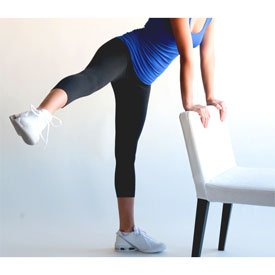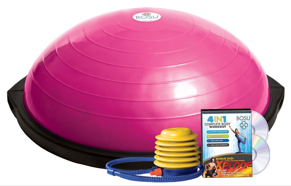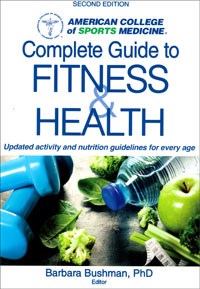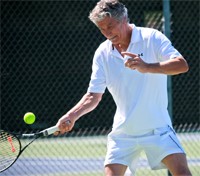|
Balance: An Overlooked Element of Fitness?
Author:
Stan Reents, PharmD
Original Posting:
05/06/2007 06:10 AM
Last Revision: 04/29/2019 08:20 AM
Most authorities in sports medicine define fitness according to the following 5 elements:
- aerobic (cardiopulmonary) fitness
- muscular strength
- muscular endurance
- flexibility
- body composition
I propose that "balance" be included in that list. Poor balance, combined with loss of muscular strength in the legs, are reasons why falls in the elderly are so common. While loss of balance has many causes (low blood pressure; poor vision; cerebral insufficiency; parkinsonism; residual effects from a stroke; ear infections; drugs, such as antibiotics and antihistamines; etc.), balance can be improved with strength training.
It may not seem logical that strength training might improve balance. However, I can verify from personal experience that it is possible. Even if you spend many hours per day on your feet, you won't obtain the same benefit as you get from balance training exercises.
As calf muscles fatigue, people need to exert more conscious attention on maintaining their balance while standing (Vuillerme N, et al. 2002). This suggests that muscle "training" -- ie., improving muscle strength and/or muscle endurance -- can be helpful to prevent falls in the elderly.
According to the American Council on Exercise (ACE), balance training activities (eg., Pilates, tai chi, yoga, etc.) and equipment (eg., BOSU® balls, foam rollers, wobble boards, etc.) are among the fastest growing and most popular exercise options for adults. In 2006, ACE listed "balance training" as one of the top 10 fitness trends. Today, health clubs and trainers are offering balance training programs for virtually all types of participants.
IMPROVING BALANCE WITH EXERCISE: FUNDAMENTAL PRINCIPLES
In December 2015, researchers published a review of 23 studies of the effects of physical training on balance (Lesinski M, et al. 2015). They concluded that an effective physical training program to improve balance:
- requires at least 11-12 weeks of training, and, at least 36-40 sessions
- should be performed at least 3 times per week
- each training session should last 30-45 minutes
BALANCE EXERCISES THAT REQUIRE NO EQUIPMENT
Standing on One Leg
One of the easiest exercises you can do to improve your balance is to simply stand on 1 leg. Sure, this seems easy. But, see if you can do it for 30 seconds with your eyes closed. You'll be surprised at how difficult this is. Try it with your arms straight out from your side (form the letter "T" with your arms and body), and then try it with your arms folded across your chest.
If, at first, it's too difficult to stand on 1 leg with your eyes closed, then do 1-legged stands with your eyes open. For many people, even this will be challenging. Then, as you get better, close your eyes for several seconds and try to improve on this each time. Stand on 1 leg for 15 seconds with your eyes open, followed by 5 seconds with your eyes closed. Then, do 10 seconds of each, then do only 5 seconds with your eyes open followed by 15 seconds with your eyes closed. Finally, do 20 seconds with your eyes closed and keep increasing that until you can do 30 seconds.

Here are some tips:
• Before you close your eyes, make sure your body weight is centered over your standing leg and you are motionless. Get your balance, then, close your eyes.
• Keep your free leg close to your body center. Or, you can position your free foot against the ankle or lower part of the leg you are standing on.
• Until you get used to these exercises, stand behind a sturdy chair, or do them while facing the kitchen counter. You can keep your eyes closed, but steady yourself intermittently by placing your hands on the back of the chair or the countertop.
In addition to realizing how good (or bad) your balance is, you'll discover how active the small muscles in your foot, ankle, and lower leg are during this drill: they are working hard to maintain your balance. This is good; these are the muscles you want to train.
Next, to improve the strength of the larger leg muscles involved in balance, consider these exercises:
One-Leg Waist Bends
First, stand on 1 leg and get balanced. Now, bend forward at the waist and touch your fingers to the knee of your supporting leg, then straighten up. As you develop better balance and better leg strength, see if you can reach your shin, then, your ankle, then, all the way to the ground in front of you. To maintain your balance, swing your other leg straight out behind you. (This motion resembles what golfers do when they reach in the cup to retrieve their ball.) Be careful if you have low back problems. You can also reach down to the side while swinging your free leg out to the opposite side. This drill is easy to do once, but try to do 10 in a row without putting your other foot on the ground.
One-Leg Squats
(NOTE: If you have knee problems, be very careful of this exercise.) Start by performing this exercise on the bottom step of a flight of stairs that has a hand rail you can grasp. Stand with 1 foot on the bottom step and hang your other foot/leg free. Hold on to the handrail. Then, squat down by bending the knee of the leg you are standing on. Keep your free leg straight until that foot touches the ground. Then, straighten your supporting leg and stand back up. You have just done a 1-leg squat. Most people should be able to do this because it only requires you to lower your body about 8-10 inches.
Here are some tips: Keep your arms and free leg as close to your body center as possible. This drill is a lot easier if you keep your free leg close to the other, as opposed to swinging it out wide. If you swing your free leg out wide in an attempt to maintain your balance, you will overcorrect and start to wobble.
This exercise requires a lot of strength in the quads. If you do it for a few days, you'll be amazed at how fast you will improve not only the strength of your thighs, but, also, how your balance will improve. See if you can do 6-10 reps in a row. If your thighs are screaming after only 4-5 reps, then stop. You can always do more next week.
EXERCISES WITH BOSU® BALLS

If you took a Swiss exercise ball, cut it in half, and put it on a stable base, you'd have a BOSU® ball. (BOSU® stands for "both sides up".)
You can obtain the BOSU Home Balance Kit for $129.
BOSU® balls allow for some creative 2-leg balance drills and make 1-leg balance drills a lot more challenging. So, you may want to start with drills described above where you are standing on the ground.
First, stand on the BOSU® ball with both legs, shoulder-width apart. NOTE: If you've never used a BOSU ball before, do this with a personal trainer or spotter! Keep your arms at your sides. For some people, even this will be difficult. Then, as you get used to it, add the following elements to make it more challenging:
• Move your arms into different positions while attempting to stand motionless: move both arms out front, both arms pointing to one side, etc.
• Begin doing squats
• Have a friend toss you a ball or a pillow; at first, have them toss it towards your mid-section, then, as you get better have them toss it to your sides.
• Move your feet closer and closer together until they are touching and attempt to maintain your balance while standing still
• For maximum difficulty, repeat all of the above while standing on 1 leg
OTHER TIPS
• When doing balance exercises, avoid looking down. Keep your head and eyes level. Try to keep your back relatively straight.
• When training with a BOSU® ball, start with exercises where both feet are on the ball. Then progress to exercises that involve standing on 1 foot.

FOR MORE INFORMATION
Books:
In 2017, ACSM published the 2nd edition of "Complete Guide to Fitness & Health." This book is intended for consumers. But it's a very thorough resource, and may be a bit too technical for some readers. However, it is very current and is backed up by solid science. Balance exercises are found in Chapter 8.
Readers may be interested in the following reviews:
EXPERT HEALTH and FITNESS COACHING
Stan Reents, PharmD, is available to speak on this and many other exercise-related topics. (Here is a downloadable recording of one of his Health Talks.) He also provides a one-on-one Health Coaching Service. Contact him through the Contact Us page.
REFERENCES
Howe TE, Rochester L, Jackson A, et al. Exercise for improving balance in older people. Cochrane Database Syst Rev 2007;4:CD004963. Abstract
Lesinski M, Hortobagyi T, Muehlbauer T, et al. Effects of balance training on balance performance in healthy older adults. A systematic review and meta-analysis. Sports Med 2015;45:1721-1738. Abstract
Orr R, Raymond J, Fiatarone Singh M. Efficacy of progressive resistance training on balance performance in older adults. A systematic review of randomized controlled trials. Sports Med 2008;38:317-343. Abstract
Vuillerme N, Forestier N, Nougier V. Attentional demands and postural sway. The effect of the calf muscles fatigue. Med Sci Sports Exerc 2002;34:1907-1912. Abstract
ABOUT THE AUTHOR

Stan Reents, PharmD, is a former healthcare professional. He is a member of the American College of Lifestyle Medicine (ACLM) and a member of the American College of Sports Medicine (ACSM). In the past, he has been certified as a Health Fitness Specialist by ACSM, as a Certified Health Coach by ACE, as a Personal Trainer by ACE, and as a tennis coach by USTA. He is the author of Sport and Exercise Pharmacology (published by Human Kinetics) and has written for Runner's World magazine, Senior Softball USA, Training and Conditioning and other fitness publications.
Browse By Topic:
balance exercise, exercise and health, exercise guidelines, exercise recommendations, health and fitness targets, measuring fitness
Copyright ©2026 AthleteInMe,
LLC. All rights reserved.
|